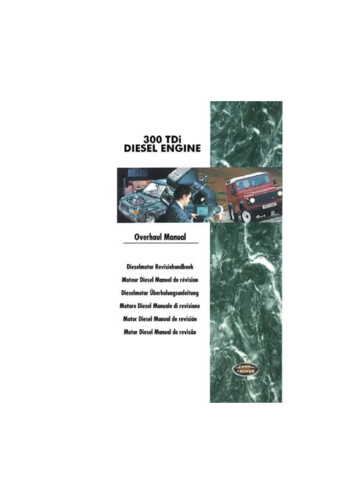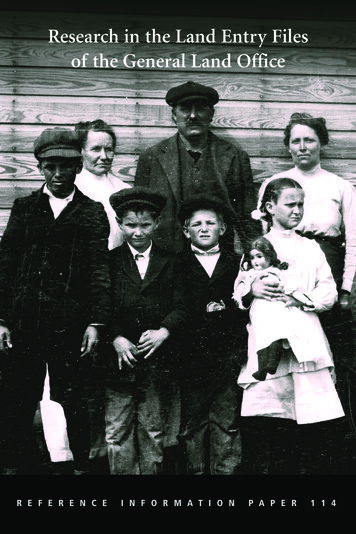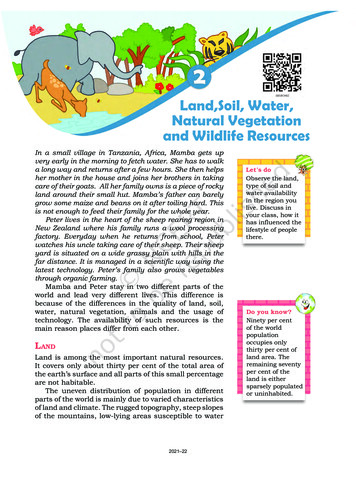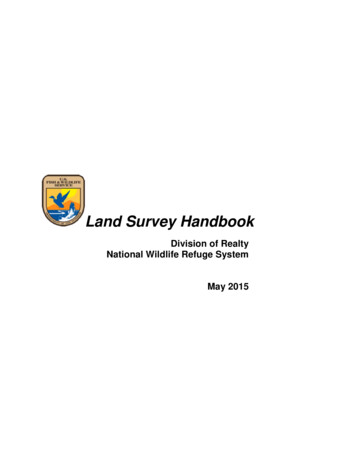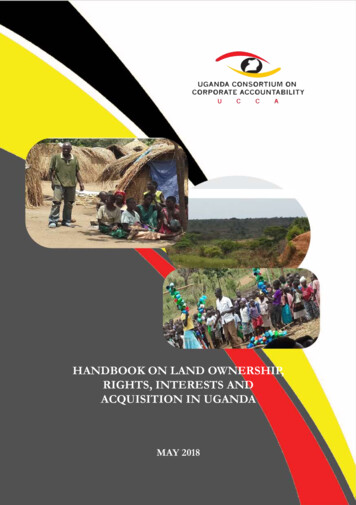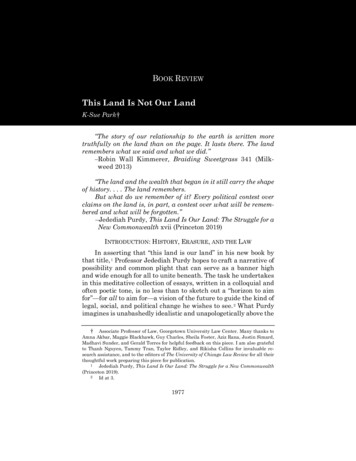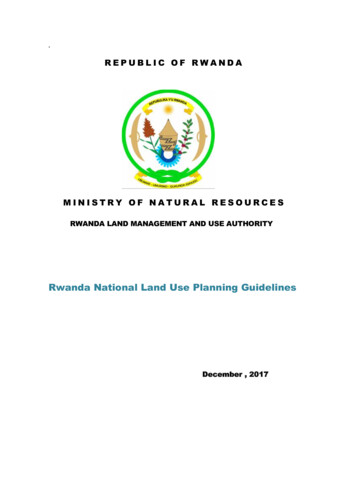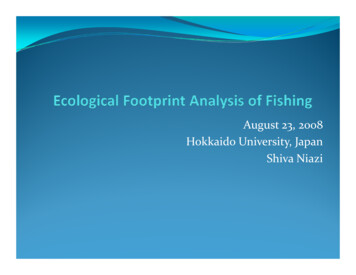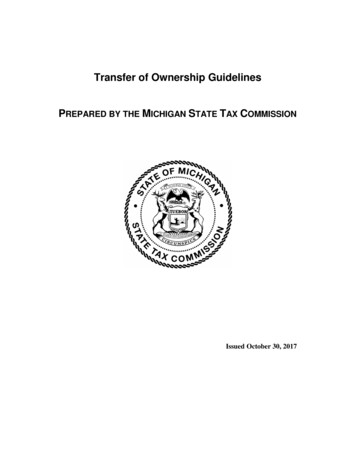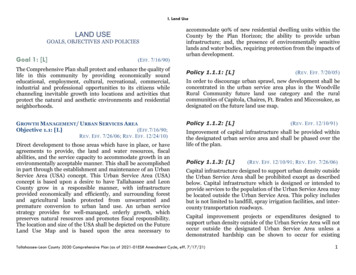
Transcription
I. Land UseLAND USEGOALS, OBJECTIVES AND POLICIESGoal 1: [L](EFF. 7/16/90)accommodate 90% of new residential dwelling units within theCounty by the Plan Horizon; the ability to provide urbaninfrastructure; and, the presence of environmentally sensitivelands and water bodies, requiring protection from the impacts ofurban development.The Comprehensive Plan shall protect and enhance the quality oflife in this community by providing economically soundeducational, employment, cultural, recreational, commercial,industrial and professional opportunities to its citizens whilechanneling inevitable growth into locations and activities thatprotect the natural and aesthetic environments and residentialneighborhoods.Policy 1.1.1: [L]GROWTH MANAGEMENT/ URBAN SERVICES AREAObjective 1.1: [L](EFF.7/16/90;REV. EFF. 7/26/06; REV. EFF. 12/24/10)Policy 1.1.2: [L]Direct development to those areas which have in place, or haveagreements to provide, the land and water resources, fiscalabilities, and the service capacity to accommodate growth in anenvironmentally acceptable manner. This shall be accomplishedin part through the establishment and maintenance of an UrbanService Area (USA) concept. This Urban Service Area (USA)concept is based upon a desire to have Tallahassee and LeonCounty grow in a responsible manner, with infrastructureprovided economically and efficiently, and surrounding forestand agricultural lands protected from unwarranted andpremature conversion to urban land use. An urban servicestrategy provides for well-managed, orderly growth, whichpreserves natural resources and promotes fiscal responsibility.The location and size of the USA shall be depicted on the FutureLand Use Map and is based upon the area necessary to(REV. EFF. 7/20/05)In order to discourage urban sprawl, new development shall beconcentrated in the urban service area plus in the WoodvilleRural Community future land use category and the ruralcommunities of Capitola, Chaires, Ft. Braden and Miccosukee, asdesignated on the future land use map.(REV. EFF. 12/10/91)Improvement of capital infrastructure shall be provided withinthe designated urban service area and shall be phased over thelife of the plan.Policy 1.1.3: [L](REV. EFF. 12/10/91; REV. EFF. 7/26/06)Capital infrastructure designed to support urban density outsidethe Urban Service Area shall be prohibited except as describedbelow. Capital infrastructure which is designed or intended toprovide services to the population of the Urban Service Area maybe located outside the Urban Service Area. This policy includesbut is not limited to landfill, spray irrigation facilities, and intercounty transportation roadways.Capital improvement projects or expenditures designed tosupport urban density outside of the Urban Service Area will notoccur outside the designated Urban Service Area unless ademonstrated hardship can be shown to occur for existingTallahassee-Leon County 2030 Comprehensive Plan (as of 2021-01ESR Amendment Cycle, eff. 7/17/21)1
I. Land Usedevelopment or residents as of February 1, 1990. A demonstratedhardship refers to: Replacement of existing facilities due to deterioration ordestruction from natural disaster.A public health and/or safety problem if no improvementsare made (example - contaminated water wells).Potential of severe environmental degradation if noimprovements are made (example - failing septic tanks).The capacity of these facilities shall be limited to that necessaryto serve development existing on or prior to February 1, 1990.Policy 1.1.4: [L](REV. EFF. 7/20/05)Central water and sewer may be provided in areas designated asRural Community, Woodville Rural Community, and enclaveswithin the Woodville Rural Community designated forResidential Preservation on the future land use map.Policy 1.1.5: [L](EFF. 7/16/90; REV. EFF. 7/26/06)Future Land Use Map densities and intensities are intended toreflect the availability of capital infrastructure. Capitalinfrastructure, which supports higher land use densities andintensities, consists of sewer and water, roads, mass transit, solidwaste, drainage, and parks.Policy 1.1.6: [L](EFF. 7/16/90)Areas within the urban service area will receive urban level capitalfacilities and services according to the schedule established in theCapital Improvements Element.Policy 1.1.7: [L](EFF. 7/16/90)Higher density and mixed use development and its ancillaryactivities shall be channeled into locations which have properaccess to the existing transportation system; minimalenvironmental constraints; sufficient stormwater treatmentcapacity; compatible existing land use and readily available sewerand water infrastructure.Policy 1.1.8: [L](EFF. 7/26/06; REV. EFF. 12/24/10)The size of the USA is related to the projected fiscal capacity ofthe local government to provide urban infrastructure. Anassessment of changing conditions over the 20-year period of theplan is built in through the required seven year Evaluation andAppraisal Report (EAR) and the annual capital improvementsprocess. The integrity of the USA concept is maintained by strictadherence to the premise of not funding or scheduling majorcapital improvement projects outside the USA, RuralCommunities or the Woodville Rural Community in conjunctionwith a policy of discouraging premature use and underutilizationof land designated for urban development. Additionally, the sizeof the USA should be limited to reflect the ability of the public toprovide infrastructure, limitations of environmental constraintsand existing development and to provide for a phasingmechanism to the Plan Horizon.The area within the USA is sized to accommodate approximately50% more vacant land than is necessary to accommodate thepopulation growth expected within the USA from 1993 to the PlanHorizon. It is expected that a USA sized 50% larger than ourvacant land needs will provide sufficient constraint for growthmanagement policies to be effective, while not over constrainingthe supply of vacant land.Tallahassee-Leon County 2030 Comprehensive Plan (as of 2021-01ESR Amendment Cycle, eff. 7/17/21)2
I. Land UsePolicy 1.1.9: [L](EFF. 7/26/06)In order to achieve efficient and effective use of infrastructureand land, residential density within the USA shall average no lessthan 2 dwelling units per gross acre. Some future land usecategories may establish higher minimum densities velopment. Attainment of minimum densities and intensitieswill be measured and reported annually and be evaluated at aminimum during subsequent Evaluation and Appraisal Reportsand adjustments to the Comprehensive Plan necessary to achievethis measure will be recommended as warranted in the future.Policy 1.1.10: [L] (EFF.7/16/90; RENUMBERED EFF. 7/26/06;FORMERLY POLICY 1.1.8.)Compliance with the Conservation Element shall be met prior toconsideration of requirements in the Land Use Element.Policy 1.1.11: [L](REV. EFF. 3/14/07; REV. EFF. 1/7/10)The growth management strategy of the Tallahassee-LeonCounty Comprehensive Plan is designed to be implemented by aseries of instruments which include:1) An Urban Service Area strategy to guide and coordinateland use densities and intensities with the availability ofcapital infrastructure and to discourage urban sprawl.2) A Land Use Map to graphically distribute broadcategories of land use and allowable densities andintensities. In conjunction with the Land Use Map, anenvironmental overlay system has been included whichdepicts the general location of environmental featureswhich are to be preserved as required by the ConservationElement, or to which development limitations will apply asidentified in the Conservation Element.3) A Future Right-of-Way Needs Map to graphicallyrepresent planned future transportation projects in theCity of Tallahassee (City) and Leon County (County) and atable of projects indicating the project termini and accessclassifications. This map, table, and corresponding landdevelopment regulations are intended to provide a basisfor coordinating new development with the provision oftransportation facilities by designating corridors wherethe construction and improvement of transportationfacilities is expected. Objectives and policies related to theFuture Right-of-Way Needs Map are provided in theTransportation Element. (EFF. 7/1/04)4) Commercial Site Location standards, which apply tocertain Future Land Use Categories other than CentralCore, Central Urban, Village Mixed Use, Suburban,Bradfordville Mixed Use, Planned Development andWoodville Rural Community shall be implementedthrough the Land Development Regulations, are intendedto integrate commercial land uses into the transportationnetwork and development patterns in order to assureaccessibility by the general public. (REV. EFF. 3/14/07; REV.EFF. 1/7/10)5) Land Use Category Summaries for each Future LandUse which in conjunction with the land use map providethe allowable densities and intensities of uses use onspecific sites.Tallahassee-Leon County 2030 Comprehensive Plan (as of 2021-01ESR Amendment Cycle, eff. 7/17/21)3
I. Land Use6) The Planned Development Future Land UseCategory applies to large land holdings that will bedeveloped for a mix of land uses. (REV. EFF. 3/14/07)(a) Provide opportunities for a “main street” component that7) Descriptions of eight different Mixed Use developmentpatterns which establish development pattern intent,allowed density and intensity, development patternlocation criteria, and development pattern access criteriawithin the Bradfordville Mixed Use Category (seeObjective 1.7) (REV. EFF. 3/14/07)three options for aesthetic enhancements if buildingfacades are not oriented towards Thornton Road and US90,8) Goals, Objectives and Policies which further addguidance by outlining courses of action to be taken inconjunction within the instruments listed above to furtherassure implementation.These instruments do not act independently of each other.Rather, they combine to form a set of parameters in which landuse decisions are made consistent with a growth managementstrategy designed to address the issues important to thecommunity.Policy 1.1.12: [L](EFF. 8/9/12)allows on street parking,(b) Provide landscaping, buffering and screening or any of the(c) Incorporate storm water management facilities andnatural features as amenities into the project’s overalldesign concept,(d) Incorporate a consistent design theme for freestandingsignage throughout the property,(e) Coordination of appropriate location for mass transitstops and pedestrian connections to development on theproperty at the time of development,(f) Buildings will incorporate architectural features andpatterns that provide visual interest such as buildingfacades that are not uniform in mass or scale and heightand pedestrian scale facade treatments such as canopies,overhangs, arcades, gabled entryways, and porticos.The parcel shown on the map below at the intersection of I-10 andUS Highway 90 is within the designated Urban Service Area(USA), as defined in Section 163.3164(50), Florida Statutes,having public services and facilities, including, but not limited to,central water and sewer capacity and roads. As a parcel within adesignated statutory USA, proposed development within theparcel is exempt from the development-of-regional impactprocess pursuant to Section 380.06(29)(c)3, Florida Statutes. Aspart of this exemption, any future development on the subjectparcels shall, in addition to applicable Comprehensive Planpolicies, address the following objectives:Tallahassee-Leon County 2030 Comprehensive Plan (as of 2021-01ESR Amendment Cycle, eff. 7/17/21)4
I. Land UseMap 1: I-10 and Mahan US 90 DRI Exemption AreaPolicy 1.2.1: [L] City of Tallahassee only(REV. EFF. 7/1/04)Emphasize land use location that minimizes topographicalchanges. The proposed land use should fit the site location. Thelocation should not be substantially altered to fit the proposedland use, unless an off-site mitigation plan for the developmentof a site with significant grades has been approved. Such off-sitemitigation plans shall recognize the contribution of preservedsignificant grades to community character, ameliorating theimpacts of stormwater, and providing conditions for native plantcommunities.Policy 1.2.2: [L] Leon County only (REV. EFF. 9/19/91)DEVELOPMENTCONSTRAINTSINObjective 1.2: [L]RELATIONTOENVIRONMENTAL(EFF. 7/16/90; REV. EFF. 4/10/09)Coordinate the location of land uses with local soil conditions,topography, and aquifer vulnerability as well as availableservices.Policy 1.2.1: [L] Leon County only(EFF. 7/16/90)Emphasize land use location that minimizes topographicalchanges. The proposed land use should fit the site location. Thelocation should not be substantially altered to fit the proposedland use.The type, intensity and structural design of any developmentproposed for a site shall be appropriate to the existing naturaltopography. Site alterations will be limited to the absoluteminimum necessary to develop a site safely. Design criteria in theland development regulations will emphasize site designs that fitthe topography, not changing the topography to fit the design.Minimum grade changes typically associated with sitedevelopment include those necessary for the safety of a buildingincluding parking, road right-of -way, handicapped access orutilities. Criteria for approval of development in areas withsignificant and severe grades will be limited to the type of landuse that requires the least disturbance of sloped areas.Policy 1.2.2: [L] City of Tallahassee only(REV. EFF. 7/1/04)The type, intensity and structural design of any developmentproposed for a site shall be appropriate to the existing naturaltopography. Site alterations will be limited to the absoluteTallahassee-Leon County 2030 Comprehensive Plan (as of 2021-01ESR Amendment Cycle, eff. 7/17/21)5
I. Land Useminimum necessary to develop a site safely. Design criteria in theland development regulations will emphasize site designs that fitthe topography, not changing the topography to fit the design,unless an off-site mitigation plan for the development of a sitewith significant grades has been approved. Minimum gradechanges typically associated with site development include thosenecessary for the safety of a building including parking, roadright-of -way, handicapped access or utilities. Criteria forapproval of development in areas with significant and severegrades will be limited to the type of land use that requires the leastdisturbance of sloped areas.Policy 1.2.4: [L]By 2010, local government shall adopt in the Land DevelopmentRegulations a mapped Primary Spring Protection Zone forWakulla Springs based on the Leon County Aquifer VulnerabilityAssessment. Accompanying land development regulations for thePrimary Spring Protection Zone shall be developed as indicatedin Policy 4.2.5 of the Conservation Element to aid in theprotection of Wakulla Springs. These efforts shall be coordinatedwith Wakulla County.Policy 1.2.5: [L]Policy 1.2.3: [L](REV. EFF. 12/7/99)(a) The local governments shall maintain a map indicatingthe locations of all known operating and abandoned landfill sites. As the location of additional abandoned land fillsites become known, this map shall be revisedaccordingly.(b) By 2001, local government will include requirements intheir land development regulations that thedevelopment of any property within a mapped landfillsite shall be required to submit information relating tothe subsurface geology of the property necessary toassure that future development of the site will notadversely impact the health, safety or welfare of thepublic.(c)By 2001, local governments will include requirements intheir land development regulations that regulate thelocation of stormwater facilities or conveyance systemswithin any abandoned landfills.(EFF. 4/10/09)(EFF. 4/10/09)1. By 2014, local government shall develop and maintain aspart of the local geographic information system databaseareas of known hazards.2. By 2014, local government will include requirements intheir land development regulations that mitigate and/orprevent future development in areas of known hazards.The land development regulations shall also containprovisions for the mitigation of existing development inareas of known hazards so as to prevent repetitive hazardlosses.LEVEL OF SERVICE (REGULATIONS)Objective 1.3: [L](EFF. 7/16/90)Achieve and maintain the adopted level of service standards setforth within the Tallahassee-Leon County Comprehensive Plan.Tallahassee-Leon County 2030 Comprehensive Plan (as of 2021-01ESR Amendment Cycle, eff. 7/17/21)6
I. Land UsePolicy 1.3.1: [L](EFF. 7/16/90)those fees collected in new developments are applied tomaintain levels of service established by the entirecommunity. Maintenance and enhancements to theadopted levels of service shall be the responsibility ofboth. This policy shall not preclude new developmentpaying toward current deficits if such an arrangementcan be worked out between the local government and thedeveloper.Before a development order or permit is issued, local governmentshall ensure that the adopted level of service standards for theaffected public facilities will be maintained in accordance with theConcurrency Management System.Policy 1.3.2: [L](REV. EFF. 12/16/94)Residential density and/or non-residential intensity ofdevelopment allowed for individual sites shall be determined bythe degree of compliance with the goals, objectives and policies ofthe Comprehensive Plan and the land use development matrix,which is intended to be a pictorial representation of existingpolicies in the plan, as implemented by the land developmentregulations. Overall densities and intensities should be consistentwith capital facilities and services being available at the adoptedlevel.Policy 1.3.3: [L](REV. EFF. 12/10/91)Environmental and development ordinances shall include thefollowing:(a) Explicit and strict protection of environmentallysensitive areas, thus minimizing future costs totaxpayers by prohibiting unsound uses; and(b) Availability and use of the conservation and preservationoverlays as detailed in the Conservation Element prior tothe issuance of development orders.(c)Apportioning development costs so that those feescollected from the existing population be applied toelimination of current “deficits” in levels of service, while(d) Policies and procedures in the land developmentregulations shall ensure that the range of developmenttypes by percentage distribution are monitored andmaintained.This policy shall not preclude new development paying towardcurrent deficits if such an arrangement can be worked outbetween the local government and the developer.Policy 1.3.4: [L](DEL. EFF. 3/14/07)ReservedLAND DEVELOPMENT REGULATIONSObjective 1.4: [L](REV. EFF. 7/20/05)Maintain a set of specific and detailed Land DevelopmentRegulations, which implement and are consistent with the goals,objectives and policies of the Tallahassee-Leon CountyComprehensive Plan.Policy 1.4.1: [L](REV. EFF. 12/10/91)Density and intensity incentives shall be established within therequired land development regulations to encourage growth inTallahassee-Leon County 2030 Comprehensive Plan (as of 2021-01ESR Amendment Cycle, eff. 7/17/21)7
I. Land Useareas which minimize and mitigate development's negativeimpact on the natural and aesthetic environment.Policy 1.4.2: [L](REV. EFF. 12/16/94; R EV. EFF. 1/7/10)The Comprehensive Plan shall establish guidelines for theapplication of traditional zoning districts in order to implement afuture land use regulatory system that is more predicable thanarea-wide application of mixed use performance zoning. Thesetraditional zoning districts shall specify a range of allowable landuse within each district. In certain land use designations, mixeduse performance zoning will be retained to integrate land useswhich may be otherwise incompatible. Development regulationsshall include development and design standards. Allowed landuses within a future land use category shall be implemented byone or more specific zoning districts consistent with the intent ofa future land use category. The development and application ofspecific zoning districts to a zoning map implementing theComprehensive Plan shall be based upon furthering the intent ofthe Comprehensive Plan:(a) Zoning district use classifications shall be developed,based upon the Comprehensive Plan, existing land usepatterns, previous zoning which continues to direct landuse and development standards, and accepted guidelinesfor land use impact classifications and servicerequirements;(b) Specific zoning districts shall be implemented throughthe application of the zoning district classificationsystem as guided by the Comprehensive Plan.(c)All zoning decisions will be made by the governingCommission based upon a finding of the furthering ofand consistency with the intent of the ComprehensivePlan, in recognition of Land Use Policy 1.1.10, whichestablishes the supremacy of the Conservation Element.(d) Specific zoning districts will be applied within the UrbanService Area except for University Transition, ActivityCenter, Central Urban, Central Core land usedesignations and Mixed Use parcels greater than 200acres in area. Extension of site specific zoning beyond theUrban Service Area and to other areas is consistent withthe intent of the Comprehensive Plan.Policy 1.4.3: [L](DEL. EFF. 7/25/03)ReservedPolicy 1.4.4: [L](DEL. EFF. 7/20/05)ReservedPolicy 1.4.5: [L](REV. EFF. 3/14/07)The Tallahassee-Leon County Comprehensive Plan, its futureland use map and future land use categories as defined within thePlan, the land use summary charts which are intended to be apictorial representation of existing policies in the comprehensiveplan, and land development regulations adopted by localgovernment as provided in the Plan shall in combination providea unified system for the regulation of land use. Land useregulations shall be consistent with the intended functions, landuses and intensity of the land use category designated on thefuture land use map.(a)Tallahassee-Leon County 2030 Comprehensive Plan (as of 2021-01ESR Amendment Cycle, eff. 7/17/21)Any requested text amendment to the ComprehensivePlan shall be evaluated for consistency with the overall8
I. Land Useintent of the adopted Goals, Objectives, and Policies ofthe Plan;(b)Any requested amendment to the Future Land Use Mapshall be evaluated for consistency with the adoptedGoals, Objectives, and Policies of the Plan as well asconsistency with and the furtherance of the intent of therequested future land use category;Policy 1.4.7: [L](EFF. 7/16/90)The adopted land development regulations shall includerequirements for stormwater management, open space, andconvenient on-site traffic flow (including need).Policy 1.4.8: [L](EFF. 7/16/90)(c)Any request for a change in zoning use classification andspecific zoning district mapping within a future land usecategory shall be evaluated for consistency with theadopted Goals, Objectives, and Policies of the Plan aswell as consistency with and the furtherance of the intentof the future land use category in which it is located;The land use development matrix shall be adopted as part of thecomprehensive plan and shall in conjunction with the future landuse map and the goals, objectives and policies contained withinthe individual elements be used in evaluating future land usedecisions.(d)The determination that a particular land use is permittedwithin a zoning district shall be made based upon alisting of allowable land uses within a zoning district orthat an unlisted land use is substantially similar toallowable uses within the same district.Policy 1.4.9: [L]Policy 1.4.6: [L](EFF. 7/16/90; REV. EFF. 4/10/09)By 2014, land development regulations will include standards forthe regulation of future land use categories, subdivision, signage,and areas subject to seasonal or periodic flooding and areas ofknown hazards. Regulations concerning areas subject to seasonalor periodic flooding shall be consistent with all applicable stateand federal regulations.(EFF. 7/16/90)Changes in classification of highways and streets that affect theallowable uses of property as set forth in the land developmentmatrix and the comprehensive plan shall be considered planamendments and shall be required to follow the plan amendmentprocess.Policy 1.4.10: [L](REV. EFF. 12/16/94)The land development regulations shall provide for zoningdistricts which shall indicate which land uses are allowed,prohibited, or conditional-with-specified constraints consistentwith the criteria set forth in the narrative intent of the future landuse categories, the land use development matrix which isintended to be a pictorial representation of existing policies in theComprehensive Plan, and the Goals, Objectives, and Policies ofthe Comprehensive Plan.Tallahassee-Leon County 2030 Comprehensive Plan (as of 2021-01ESR Amendment Cycle, eff. 7/17/21)9
I. Land Use(a)In those future land use categories that encourage amixing of land uses, the land development regulationsshall contain provisions that facilitate multiple land useswithin the same site, the same development, or the samestructure.(b)When appropriate, the land development regulationsmay provide for zoning districts that allow for two ormore land use types, consistent with the intent of thefuture land use category.(c)The land development regulations may also provide forzoning districts that further divide any of the allowedland use types into two or more subsets.Policy 1.4.11: [L](a)(b)Objectionable impacts of service and delivery areas,refuse and recycling collection areas, as well as theoutdoor storage and work areas generally associatedwith commercial and residential buildings shall beplanned to minimize off-site impacts.(c)Site Plan and PUD requirements shall minimize impactsto the natural environment resulting from urban sprawlby not only identifying and protecting environmentallysensitive lands, but just as importantly by limiting urbansprawl into less environmentally sensitive lands throughthe implementation of compact and efficient urbandevelopment and redevelopment.(EFF. 9/19/91)The land development regulations shall include standards andcriteria such as minimum open space requirements (between25% and 10% depending on the land use and existing vegetation),internal circulation and minimum setbacks and buffers foruncomplimentary land uses. These buffer requirements willcontain buffer widths between land uses, required number oftrees and shrubs per linear foot of buffer, opacity of the buffer,etc. Additional buffering requirements may be related to PlannedUnit Developments (PUDs).Policy 1.4.12: [L]efficient urban land use patterns that closely integrateliving and work spaces while maintaining compatibilitythrough specified performance design criteria.Neighborhood and inter-site compatibility shall beimplemented through site planning and design criteriathat require objectionable impacts of particular land useactivities to be internally located within site or buildingdesigns, rather than relying exclusively on standardlandscape and setback buffering methods to reduceperimeter oriented objectionable impacts.(EFF. 9/19/91)The intent of Site Plan and PUD planning and designrequirements shall be to encourage and require thedevelopment of urban living and work spaces thatminimize impacts to the natural environment.Environmental impacts shall be minimized through thedevelopment and redevelopment of compact andPolicy 1.4.13: [L](REV. EFF. 3/14/07)The intent of designating roads as nonresidential is to recognizeexisting nonresidential development patterns and to allow forplanned mixed-use or nonresidential developments. As such,street access requirements contained in the Land Use SummaryCharts are waived for those streets designated as nonresidentialby clearly defining areas where existing development patternswill be allowed to continue. It also serves to protect residentialand residential components such as elementary schools andTallahassee-Leon County 2030 Comprehensive Plan (as of 2021-01ESR Amendment Cycle, eff. 7/17/21)10
I. Land Useneighborhood parks from adverse impacts of nonresidentialdevelopment as well as protecting nonresidential developmentfrom the encroachment of residential uses.traffic impacting residential areas on other segments of the roador in the adjacent area. (A segment is the road length between twointersecting roads).The designation of a nonresidential street does not exempt anypotential development along the street from further concurrencyor consistency review.Policy 1.4.15: [L]Roadway access limitations and locational criteria from thenonresidential road classification system do not apply to theWoodville Rural Community, Suburban, Bradfordville MixedUse, Planned Development, Village Mixed Use and UrbanResidential 2 Future Land Use Categories. Roadway accesslimitations and locational criteria for these categories shall beestablished in Land Development Regulations.Waive access standards for heavy industrial land uses within theHeavy Industrial Future Land Use category and Industry andMining Future Land Use category. This will be done inconjunction with adopting a policy which waives local and minorcollector access standards for all planned industrial andcommercial development.Policy 1.4.16: [L]Policy 1.4.14: [L](EFF. 8/17/92)Compile a list and waive access standards for non-residentialminor collector and local streets based on the following criteria:a)It is part of a platted non-residential subdivision.b)It is part of an approved PUD.c)It has over 66% of its developed frontage in nonresidential land uses and essentially functions as an accessroad for these developments. The designation of thesestreets is a recognition of existing development patternsand is intended to permit future development compatiblewith existing land uses and
concept is based upon a desire to have Tallahassee and Leon County grow in a responsible manner, with infrastructure provided economically and efficiently, and surrounding forest . The parcel shown on the map below at the intersection of I -10 and US Highway 90 is within the designated Urban Service Area (USA), as defined in Section 163.3164 .
